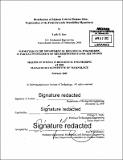| dc.contributor.advisor | William G. Thilly. | en_US |
| dc.contributor.author | Kao, Leslie E | en_US |
| dc.contributor.other | Massachusetts Institute of Technology. Department of Biological Engineering. | en_US |
| dc.date.accessioned | 2015-01-20T17:55:12Z | |
| dc.date.available | 2015-01-20T17:55:12Z | |
| dc.date.copyright | 2009 | en_US |
| dc.date.issued | 2009 | en_US |
| dc.identifier.uri | http://hdl.handle.net/1721.1/93024 | |
| dc.description | Thesis: S.M., Massachusetts Institute of Technology, Department of Biological Engineering, 2009. | en_US |
| dc.description | Cataloged from PDF version of thesis. | en_US |
| dc.description | Includes bibliographical references (pages 69-75). | en_US |
| dc.description.abstract | The multiple "hits" carcinogenesis models are extensions of the cancer incidence theory developed by researchers from Nordling (1953), Armitage-Doll (1954 and 1957), Knudson (1971), Moolgavkar and Verzon (1979), to Moolgavkar and Knudson (1981), among others. These studies relate to the evolutionary process of normal tissue cells in an individual's organ from a normal stage to an initiated pre-neoplastic stage, and finally promoted to a neoplastic stage, resulting in tumorigenesis. The most significant impact of this type of research is to gain insight into the complex process of cancer development in humans. In the case of skin cancer, epidemiological and molecular data clearly indicate that sunlight is a carcinogen, the primary cause of skin cancer, in which forms of point mutation are associated with ultraviolet radiation. Furthermore, sunlight is attributed both as a tumor initiator and a tumor promoter by favoring the clonal expansion of p53 mutated cells. By utilizing studies of the multiple genetic hit model of oncomutation and inference that preneoplasia appears to be a clonal continuation of juvenile growth in adult tissues from which one stem cell creates an embryonic organ with lethal consequences, this thesis is devoted to the analysis of the process of skin cancer development and distribution of mutant cells in human skin, as well as the calculation of and inferences based on Gostjeva and Thilly's hypothesis on mutational clone frequency is restricted to the fetal-juvenile period. | en_US |
| dc.description.statementofresponsibility | by Leslie E. Kao. | en_US |
| dc.format.extent | 75 pages | en_US |
| dc.language.iso | eng | en_US |
| dc.publisher | Massachusetts Institute of Technology | en_US |
| dc.rights | MIT theses may be protected by copyright. Please reuse MIT thesis content according to the MIT Libraries Permissions Policy, which is available through the URL provided. | en_US |
| dc.rights.uri | http://dspace.mit.edu/handle/1721.1/7582 | en_US |
| dc.subject | Biological Engineering. | en_US |
| dc.title | Distribution of mutant cells in human skin : exploration of the fetal-juvenile mutability hypothesis | en_US |
| dc.type | Thesis | en_US |
| dc.description.degree | S.M. | en_US |
| dc.contributor.department | Massachusetts Institute of Technology. Department of Biological Engineering | |
| dc.identifier.oclc | 899214963 | en_US |
